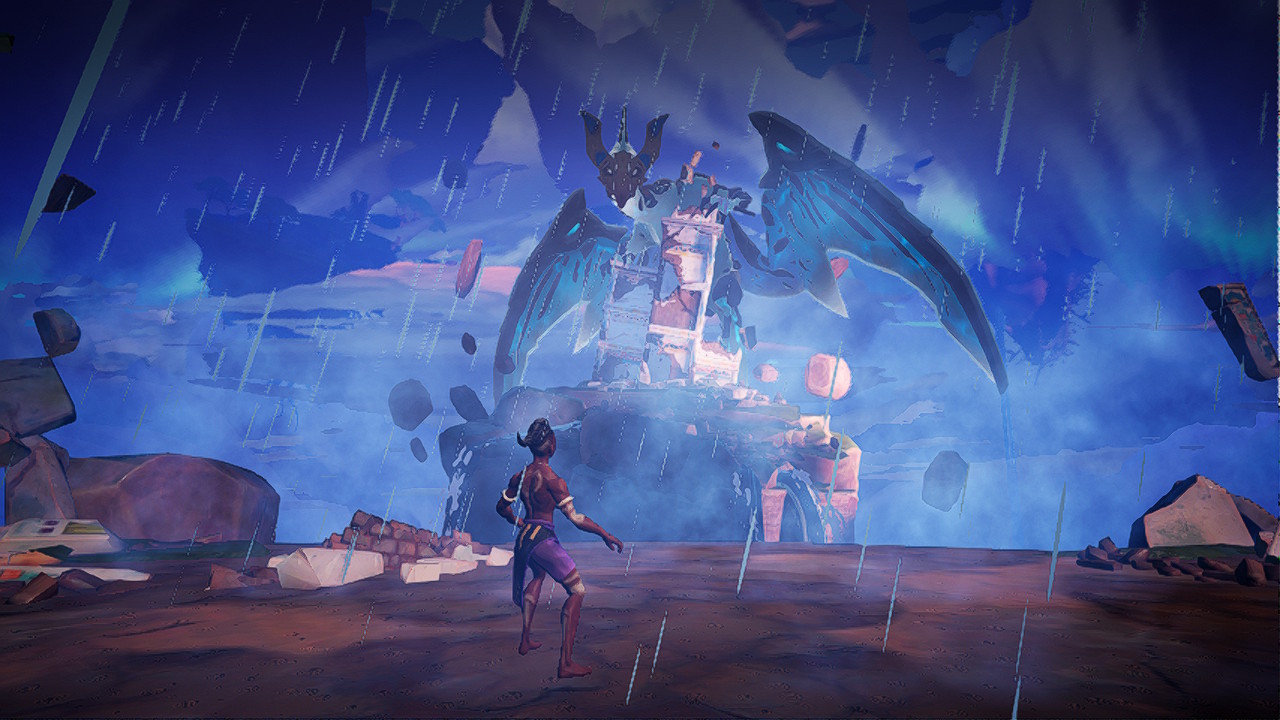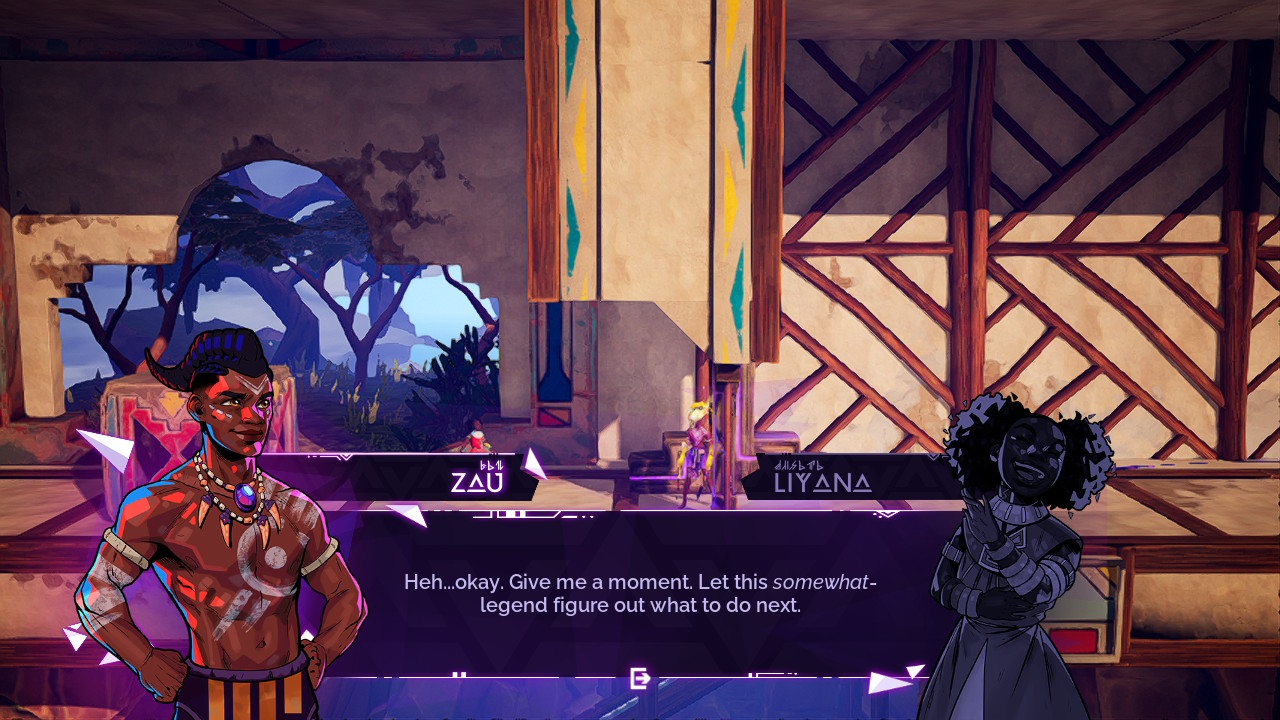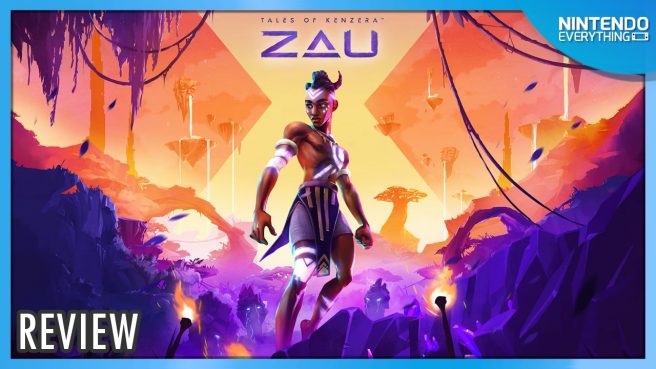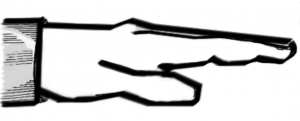[Review] Tales of Kenzera: ZAU
System: Switch
Release date: April 23, 2024
Developer: Surgent Studios
Publisher: EA
As the latest title to be published under the EA Originals label, Tales of Kenzera: ZAU joins an interesting, eclectic collection of games of varying genres and quality. As the debut title of Surgent Studios it stands out as being particularly ambitious, jockeying for position in a genre already oversaturated with memorable and high quality titles, and it takes clear inspiration from some of the best out there and delivers its own unique spin on them. Unfortunately, these are the things that stop it from becoming all that it could be, and ultimately make it a game that is tough to recommend as a result.
Kenzera is a tale within a tale, although you’ll rarely emerge outside of it. Zuberi, who has recently lost his father, discovers a book he has written that tells the tale of Zau, a young shaman on a quest to revive his own father. Joining him on his quest is Kalunga, a God of Death who he has summoned and made a pact with: if Zau can successfully capture three spirits and offer them to Kalunga, then he will bring his father back to life. It isn’t a story that is filled with any great twists or surprises that you won’t see coming almost immediately, but is nonetheless one that stands out for its powerful emotional themes, which is helped along by some truly outstanding voicework.
What I didn’t expect from the game going into it was just how narrative-focused it was, or just how brilliantly crafted and expertly delivered that narrative was going to be. For a genre that is often so light on story, Kenzera stands out for doubling down on its storytelling and bringing it to the forefront at every possible opportunity. The titular Zau’s quest is at the heart of everything you do and everywhere you visit, and the game never lets you forget it; this is not an idle excuse for you to travel between the various areas to explore and collect whatever loot you can find, but an active, ever-present goal that you’ll be constantly working towards, with every step towards that being commented on by both characters.

Dialogue between Zau and Kalunga is a frequent occurrence as you progress on your journey and is always the highlight of any given moment: the two banter, berate one another for their actions and opinions, share memories and experiences, and were more than reason enough for me to continue playing the title to the end even when I was at my most frustrated with its lacking gameplay. Despite the serious and intensely personal nature of the narrative, Kenzera’s dialogue has a very natural, down-to-earth feeling to it that gives its characters a surprising amount of depth in such a short amount of time, and it moves at a brisk pace. Echoes, which you can discover scattered throughout the map, also provide some additional background lore and add some much-needed depth to the game’s world, supporting the narrative but never feeling like required reading in order to fully understand and appreciate it.
From a gameplay standpoint Kenzera is a Metroidvania only in the loosest sense, and is lacking a lot of the features that define the genre; in many ways it would be an excellent starting point for newcomers to the genre, or for those less inclined to spend hours getting lost in sprawling maps that give you a lot of tools to experiment with and very little guidance on what to do with them. There is very little backtracking to be done here, with each area connected to a central hub and being entirely self-contained; you’ll only need to visit each one once over the course of the story, and there is no crossover between them, or option to explore them in a preferred order. In keeping with the story, your focus is on reaching your next objective rather than on exploration, and you’ll find few opportunities to deviate from the path towards your clearly marked objective, and few reasons to return to previous areas once you’ve acquired a new power-up: there aren’t many collectibles to find in each area, and most can be found naturally during your first time exploring the area. Kenzera is split into four clearly-defined acts, one for each area plus a conclusion, and each will only take a couple of hours to complete even for the most meticulous of players. Despite this I never felt particularly rushed by the game, or as if an area had overstayed its welcome, and considering the nature of the gameplay this rather brisk pacing with a lack of genre padding was something of a blessing. But this linearity and the excessive focus on platforming makes the title feel more like an action platformer than a Metroidvania, and although this isn’t necessarily a point against it, it is a point to keep in mind if you’re expecting a more traditional exploration-focused experience.

The main measure of character progression comes in the form of the Sun and Moon masks in Zau’s possession, which grant him access to different abilities depending on which one he is wearing at the time: the Moon Mask is focused on ranged attacks and abilities, with rechargeable shots and swifter movement, and the Sun Mask focuses on melee attacks which are more powerful but lack range. These can be swapped around at any time – and you’ll quite often need to – and both can be upgraded via a Skill tree. You can also find Trinkets scattered across the world, usually waiting at the end of a short platforming-focused trial, for passive boosts to the usual stats, although you cannot upgrade Zau himself in the traditional sense. You’ll also gain some abilities in each area outside of these to further improve your platforming capabilities, with the usual suspects of grappling, gliding, and dashing making an appearance. There is nothing here that will surprise anyone who has played a Metroidvania before, but to its credit Kenzera has you make full use of each new ability that you acquire, and the smaller number of them means that you’ll become more familiar with them that much quicker.
The main use of the Sun and Moon Masks is to defeat the hostile creatures that have taken up residence in the land, and Kenzera has all the makings of satisfying combat with this, but unfortunately it fails to capitalize on it by making the encounters themselves interesting. Instead, you’ll be repeatedly locked into a small room and with a mixture of the same eight enemies thrown at you in waves, forced to defeat them all before you can proceed. Lack of enemy variety makes combat become an unwelcome interruption after the first couple of hours of play, with the only slight variation between encounters coming in the form of enemies with shields that mean you’ll need to hit them with attacks from a specific mask. Boss encounters are much the same thing, only on a larger scale: all you need to do is repeatedly pound on the boss when the opportunity presents itself to emerge victorious, which is a little disappointing considering the unique, memorable designs of the few bosses that the game has. Defeating enemies rewards you with experience that will eventually culminate in a skill point to invest in your masks which does lead to additional damage and moves, but even on higher difficulties combat is never so challenging that you’ll never really need to make use of them, making this one of the more underwhelming aspects of the game.
Combat will often only last a few minutes at most, which would make this a minor inconvenience if the rest of the gameplay was of a higher standard, but unfortunately Kenzera feels equally formulaic outside of its repetitive combat. Linear pathways with no hidden secrets to uncover, wall-jumping vertical shafts to reach higher levels, and precision platforming will be how you spend the majority of your time. But what makes this feel particularly frustrating is that from beginning to end, the map is littered with instant death hazards; spikes, bottomless pits, lava; this game has it all, waiting to kill you should you make even a slight misstep.

To the game’s credit, at times this is used to good effect: on the rare occasions where you’re allowed to deviate from the beaten path to explore, you can challenge short platforming trials with prizes of Trinkets or Echoes, and these feel much more rewarding because of this. When utilized correctly, as optional challenges with additional rewards, Kenzera can feel quite satisfying to overcome, as you’ll need to make full use of your abilities to overcome the obstacles presented.
However, this approach being adopted across the entire game results in some bizarre difficulty spikes, and the demand for precision platforming becomes especially problematic at times due to some notable input delay. More than once when gliding I found myself dying due to a need to momentarily drop in altitude by releasing my hold on the B button, only to be unable to gain it again to avoid the hazard below me because the game didn’t register that I’d held the button down again. Other mid-air actions that required split-second input proved similarly troublesome, and I experienced a brief window where I was unable to move at all almost every time I exited from the menu, something I needed to do quite often to check the map. To make matters worse, the game will deposit you back to the nearest checkpoint, which is often at the start of an extended platforming sequence, meaning you will need to re-do all of it in order to get back to where you had died previously. At times, this is extremely frustrating.
Despite having a striking visual style, Kenzera isn’t a game I would recommend playing in handheld mode, as it often becomes an indistinct blur, with low resolution textures on character models in particular sometimes making it difficult to determine what is going on during combat. There are also occasional stutters that can make the precision platforming more frustrating than it needs to be, and loading times are long enough to be noticeable at times. This is unfortunate, because the game has some stunning backdrops which only occasionally suffer from the same low resolution that is a constant presence in the foreground, and each area you visit feels quite distinct despite sharing what is essentially the same sort of layout in linear pathways, narrow vertical shafts, and a lot of instant death hazards. The game’s UI is similarly attractive, with a stylized (although not especially useful) map screen, and some fantastic illustrations.
The Verdict
I didn’t enjoy my time with Tales of Kenzera: ZAU as much as I would have liked. Although the story elevates the experience well beyond what is standard for the Metroidvania genre, everything else drags the game down and makes it at best mediocre, and at no point does the gameplay match the standard set by the narrative. But as a debut title from a new studio, it’s a valiant effort that isn’t entirely without merit.
Tales of Kenzera: ZAU copy provided by the publisher for the purposes of this review.

